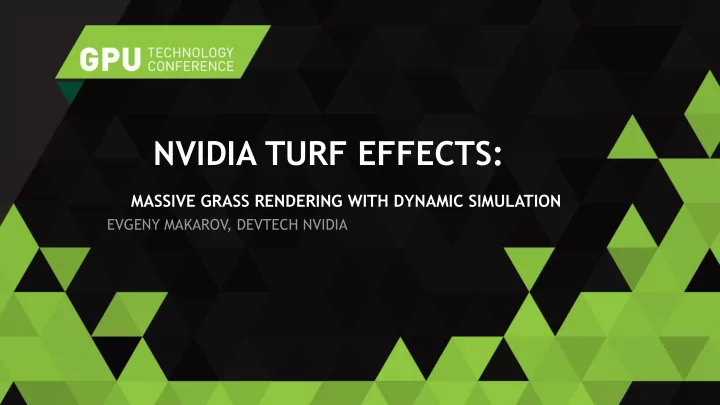

NVIDIA TURF EFFECTS: MASSIVE GRASS RENDERING WITH DYNAMIC SIMULATION EVGENY MAKAROV , DEVTECH NVIDIA
OUTLINE Real-time grass rendering Turf Effects: grass rendering Turf Effects: dynamic simulation Grass authoring Q&A
REAL-TIME GRASS RENDERING
PARTICLE BASED GRASS Billboards Top view Grass objects
PARTICLE BASED GRASS Pros Good density Plausible rendering results Good performance Cons View dependent Complicated physical interaction
GEOMETRY BASED GRASS
GEOMETRY BASED GRASS
GEOMETRY BASED GRASS Pros High density Looks good at any scale Simplified physical interaction Two-sided lighting and self-shadowing Cons High rendering complexity
TURF EFFECTS: GEOMETRY BASED GRASS
BREAK GRASS INTO A SET OF PATCHES
RENDERING A GRASS BLADE + (u1,v1) u v Vertex Hull Domain shader shader shader
PATCH INITIALIZATION Application provides a set of seed points Seed point Position Expansion Asset ID u 1 v
SEED PARAMETERS Dispersal (coverage radius) LOW HIGH Bunching (radial alignment)
GRASS PATCH RENDERING Build a list of visible patches Library renders data for a single asset type at once Render PatchesNum * AssetsNum Need to minimize API state changes Use single API call per patch per asset for (n = 0; n < patchPerAssetCount; n++) DrawInstanced (…, patchID); ~18.0 millions DrawInstanced() calls/sec* * i7 4770K 3.5GHz, GeForce GTX 960 driver 347.52
OCCLUSION CULLING Per patch occlusion culling on GPU Use application provided depth with occluders information Rasterize per patch conservative boundary boxes with read-only depth i i j k OCCLUDER k
OCCLUSION CULLING void DrawInstanced( UINT VertexCountPerInstance, UINT InstanceCount, UINT StartVertexLocation, UINT StartInstanceLocation ); … 0 0 0 . . . … 0 1 0 i i . . . … 0 0 k k-1 … 0 1 0 k … 0 0 k+1 . . .
RENDERING WITH OCCLUSION CULLING Per asset: Write per patch blade count Call DrawInstancedIndirect() to render each patch Culled patches would still issue draw calls on CPU
VARYING DENSITY Reduce blade count for distant patches Analytically defined Use fixed number of discrete LODs with smooth transitions density 1 d 0 distance level 0 level 1 level 2
VARYING DENSITY
VARYING DENSITY Close up patch view Distant patch view (<10% of original blades)
DYNAMIC SIMULATION Grass interacts with dynamic scene objects
DYNAMIC SIMULATION (2) Simulate collision with per-blade control points Use mass-spring model F2 m2 F1 m1
EXTERNAL FORCES
EXTERNAL FORCES RENDER VOLUME
EXTERNAL FORCES RENDER VOLUME
EXTERNAL FORCES v Δ F = k Δ F combined
DYNAMIC SIMULATION
SIMUALTION SUMMARY Encode dynamic objects in a form of deformation heightfield Patch-space distance to occluder Per-pixel movement speed Landscape is also a heightfield Per asset simulation parameters Stiffness Restitution Do not resolve collisions between individual grass blades
GRASS AUTHORING Seed parameters Control blades distribution Asset parameters Control individual blade look
ASSET PARAMETERS Width float4(w0, w1, w2, w3) Tip w3 w2 w1 w0 Root (1,1,1,1) (1,1,1,0) (0,1,1,1)
VARYING SMOOTHNESS
ASSET PARAMETERS (2) Edge offset Density falloff Shape variations A set of “barebones” used for particular grass type 2 user-defined CPs 3 user-defined CPs
SUMMARY Turf Effects: real-time grass simulation and rendering Currently uses tessellation (D3D 11.0 or OpenGL 4.0) Can rely on existing content Convert existing particle-based grass into geometry
Q&A
THANK YOU
Recommend
More recommend